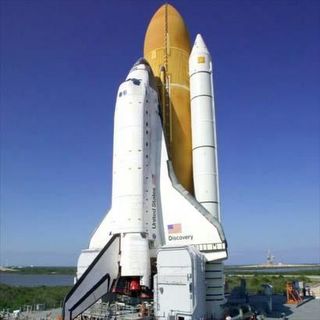"It's like Christmas is coming," deputy shuttle program manager Wayne Hale said as the seconds ticked off the countdown clock Monday and anxiety permeated the Kennedy Space Center.
Stephanie Stilson, the Cocoa woman who has spent more than two years readying Discovery for this moment, could hardly believe the eve of return to flight is here.
"Are we really going to launch?" she asked, remembering how one nit can dash such hopes, but letting herself get fired up anyway.
"It leaves me goosebumps every time I think about it," Stilson said.
So far, all looks well for a 3:51 p.m. liftoff Wednesday. Forecasters predict just a 30 percent chance of bad weather cropping up near the seaside launch pad in the form of clouds or thunderstorms. And, as of Monday evening, the launch team was working no show-stopping technical glitches.
The countdown was progressing so smoothly that Merritt Island's Bill Parsons, the shuttle program manager, said the two men on the International Space Station should be ready for guests.
"I think we're on our way," Parsons said, although he and Hale stressed some shuttle engineers planned to work through the night Monday on a handful of nagging safety concerns.
'Lots of discussion'
The Mission Management Team met for real Monday, for the first time under post-Columbia reforms aimed at convincing employees to raise their safety concerns to bosses and the managers to give such issues a full, thoughtful airing before deciding what to do next.
That kind of open discussion of safety problems did not occur during Columbia's flight, and investigators said the resulting miscommunication allowed NASA to miss opportunities to at least try to prevent the fiery re-entry accident that destroyed a spaceship and killed seven astronauts.
By contrast, on Monday, Hale said "we had lots of discussion and debate and we had numerous people coming to the microphone to talk." The meeting took three-and-a-half hours.
None of the issues that came up Monday were new surprises. Rather, the discussions were continuations of lingering debates among members of the shuttle team about whether -- in various cases -- everything possible was being done to fix problems that could lead to another accident.
For instance, some engineers want more information about glitchy fuel-depletion sensors that malfunctioned during one test this spring and worked fine in a subsequent test. The unexplained failure is worrisome because the fuel sensors, which work like a gas gauge in an automobile, are critical to safe flight. If they failed, shuttle engines could shut down too soon and force the commander to try a dangerous emergency landing at KSC or overseas.
None of the concerns was deemed showstoppers. If new information arises or some unknown trouble develops, Hale said NASA would wait to fly until all safety issues are resolved.
Several issues will be brought back up at today's daily Mission Management Team meeting.
Three launch tries
Meanwhile, on Monday morning, Commander Eileen Collins and Pilot James Kelly practiced landings at the Shuttle Landing Facility runway. Then, all seven astronauts tried on and checked out their orange launch and entry partial-pressure suits. The shuttle astronauts also were supposed to conference with the International Space Station's two-man crew and flight controllers.
NASA later evacuated pad 39B of all but essential workers to load dangerous liquid oxygen and liquid hydrogen into the orbiter storage tanks. The reactants mix in orbit to generate electricity for the ship's computers, lights and other systems. The fuel cells generate water as a byproduct, which the crew bags so it can be used to replenish supplies on the space station.
The shuttle team can make three launch tries from Wednesday through Saturday. If Discovery can't launch by Saturday, NASA would have to wait 72 hours to top off the fuel cell tanks.
The seven-hour task started an hour late, but managers said the time could be made up.
Tonight, weather permitting and barring unforeseen problems, the launch team will retract the Rotating Servicing Structure surrounding Discovery at the pad. The RSS is movable scaffolding that allows the shuttle team to install and work on the payload in Discovery's cargo bay.
Just before 5 a.m. Wednesday, managers will take a last look at the weather before deciding whether to start pumping a half-million gallons of supercold propellants into the fuel tank. Fueling would begin shortly thereafter, and the crew would start getting ready to fly.
More . . .
Home


No comments :
Post a Comment
Dear Reader/Contributor,
Your input is greatly appreciated, and coveted; however, blatant mis-use of this site's bandwidth will not be tolerated (e.g., SPAM, non-related links, etc).
Additionally, healthy debate is invited; however, ad hominem and or vitriolic attacks will not be published, nor will "anonymous" criticisms. Please keep your arguments/comments to the issues and subject matter of this article and present them with civility and proper decorum. -FW